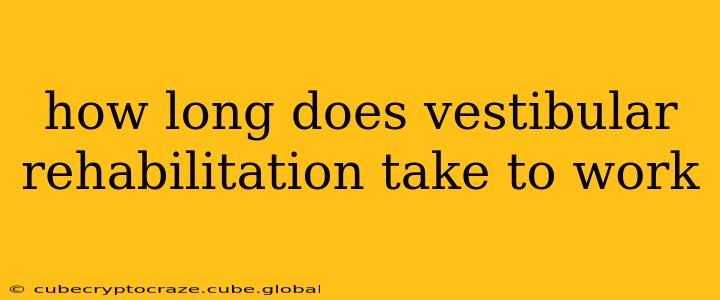Vestibular rehabilitation therapy (VRT) is a specialized form of physical therapy designed to treat balance disorders stemming from problems within the inner ear's vestibular system. While many experience improvements, the time it takes to see noticeable results varies considerably from person to person. There's no single answer to "how long does vestibular rehabilitation take to work?" Instead, progress depends on several interacting factors.
What Factors Influence the Duration of VRT?
Several key factors influence the speed and extent of improvement with vestibular rehabilitation:
-
The Underlying Cause: The specific cause of your vestibular disorder significantly impacts recovery time. A simple benign paroxysmal positional vertigo (BPPV) episode might resolve within a single session, while more complex conditions like vestibular neuritis or Meniere's disease require a more extended course of treatment.
-
The Severity of Symptoms: The intensity of your symptoms at the start of therapy plays a role. Those with mild symptoms may see improvements faster than those with severe dizziness, imbalance, or nausea.
-
Your Individual Response to Therapy: Just like any other therapy, individual responses vary. Some people respond quickly to exercises, while others require more time and patience to achieve the same level of improvement. Your overall health, fitness level, and commitment to the exercises also contribute.
-
Adherence to the Treatment Plan: Consistent adherence to the prescribed exercises and home program is crucial for successful VRT. Missing sessions or neglecting home exercises can significantly prolong the recovery process.
-
Age and Overall Health: Age and pre-existing health conditions can influence the rate of recovery. Older individuals or those with other medical issues might experience a slower recovery than younger, healthier patients.
How Long Can I Expect to See Results?
While it's impossible to give a precise timeframe, here's a general idea:
-
For BPPV: Many people experience immediate relief after a single treatment session involving specific repositioning maneuvers.
-
For Vestibular Neuritis or Labyrinthitis: Significant improvement may take several weeks or months of consistent therapy.
-
For Meniere's Disease: VRT is often part of a comprehensive management plan, and improvements might be gradual over a longer period, potentially involving ongoing maintenance exercises.
It's crucial to understand that VRT isn't always about complete symptom eradication. The goal is often to improve functional abilities, reduce symptom severity, and enhance your ability to cope with your condition. Even with substantial improvement, some residual symptoms might persist, but the overall impact on your quality of life can be significantly improved.
What if I'm Not Seeing Progress?
If you're not seeing progress after several sessions of VRT, it's essential to discuss your concerns with your physical therapist. They may need to adjust your treatment plan, consider alternative therapies, or refer you to other specialists for further evaluation. It's crucial to maintain open communication with your healthcare team throughout the process.
How Often Are VRT Sessions?
The frequency of VRT sessions varies depending on the individual's needs and the therapist's assessment. Initially, sessions might be more frequent (e.g., two or three times a week), gradually decreasing as progress is made. A home exercise program is an integral part of VRT, and consistency with these exercises is paramount for effective treatment.
What Exercises Are Involved in VRT?
VRT typically involves a range of exercises designed to improve balance, coordination, and eye-muscle control. These exercises can include:
- Gaze stabilization exercises: These help train your eyes to maintain focus despite head movement.
- Balance exercises: These challenge your balance using various surfaces and positions.
- Habituation exercises: These gradually expose you to movement that triggers dizziness, helping you adapt.
- Cervical exercises: Neck mobility exercises help address related issues, often accompanying vestibular disorders.
Ultimately, the journey with VRT is individualized. Open communication with your physical therapist, consistent effort in performing exercises, and patience are key components to a successful outcome. Remember that improvement takes time and dedication.
